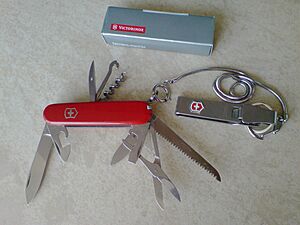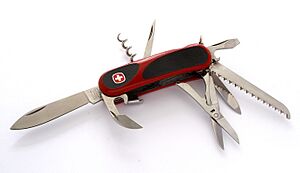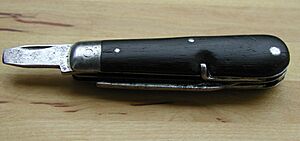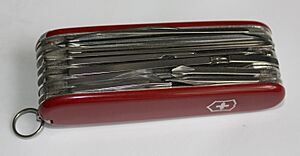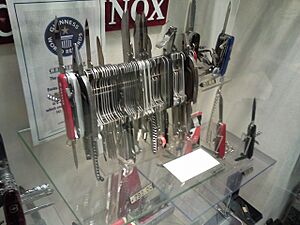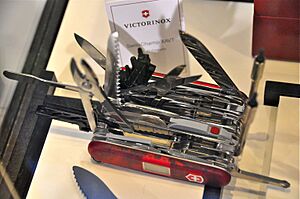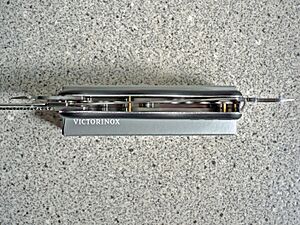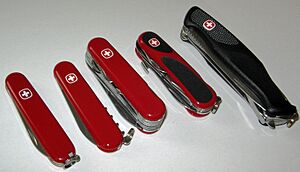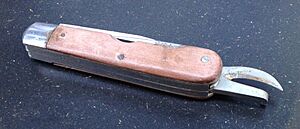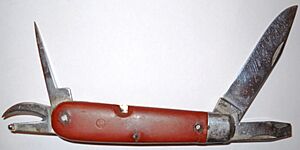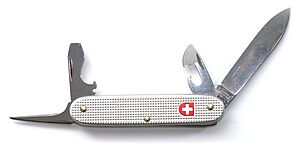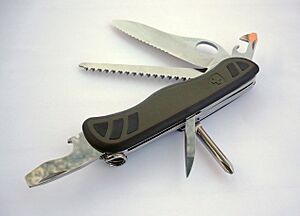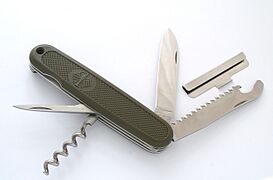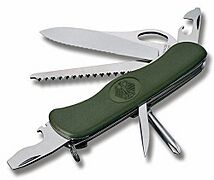Swiss Army knife facts for kids
The Swiss Army knife (often called SAK) is a special kind of pocketknife. It usually has many tools folded inside it. Today, only one company, Victorinox, makes them. American soldiers gave it the name "Swiss Army knife" after World War II. They found it hard to say the German word "Offiziersmesser," which means "officer's knife."
A Swiss Army knife typically has a main blade. It also includes other tools like a screwdriver, a can opener, a small saw, and scissors. All these tools fold neatly into the handle. The handle is usually red and has a cross logo. This logo is either the Victorinox or Wenger cross, or the coat of arms of Switzerland for military knives. Over the years, many other colors and shapes have been made.
The first Swiss Army knife was made in 1891 in Ibach, Switzerland. The company, started by Karl Elsener, won a contract to make knives for the Swiss Army. This company later became Victorinox. Another Swiss company, Paul Boéchat & Cie (later Wenger SA), also made knives for the army starting in 1893. For a long time, these two companies were the main makers. In 2005, Victorinox bought Wenger. The Swiss Army knife is famous around the world. It is a symbol of culture of Switzerland. People often use "Swiss Army knife" to describe someone or something that can do many different things.
Contents
History of the Knife
How the Knife Started
The Swiss Army knife was not the very first pocket knife with many tools. For example, in 1851, a book called Moby-Dick mentioned a "Sheffield contrivance." This was a pocket knife that held many tools inside it. These included blades, screwdrivers, and corkscrews.
In the late 1880s, the Swiss Army wanted a new folding knife for its soldiers. This knife needed to help soldiers open canned food. It also had to help them take apart and put together their service rifle, the Schmidt–Rubin. This rifle needed a screwdriver for maintenance.
In January 1891, the knife was officially named Modell 1890. It had a blade, a reamer (a tool for making holes), a can opener, and a screwdriver. The handles were made from dark oak wood. Some say later ones used ebony wood. At first, no Swiss company could make enough knives. So, the first 15,000 knives were ordered from a German company, Wester & Co. These knives arrived in October 1891.
In 1891, Karl Elsener decided to make these knives in Switzerland. His company made surgical equipment. He started making the Modell 1890 knives, competing with the German company. He lost money at first because the German company made them cheaper. To save his business, Elsener created a better knife in 1896. This new knife was for officers. It had tools on both sides of the handle. A special spring held them in place.
This new knife was patented on June 12, 1897. It had a second, smaller blade, a corkscrew, and wood fiber handles. It was called Schweizer Offiziers- und Sportmesser ("Swiss officer's and sports knife"). The Swiss military did not ask for this knife. But it sold very well around the world. This helped Elsener's company become successful again.
Elsener started using a version of the Swiss coat of arms as his knife's logo in 1909. This is still the company logo today. Also in 1909, after his mother passed away, Elsener named his brand Victoria in her honor. In 1921, after stainless steel was invented, Karl Elsener's son changed the company name to Victorinox. This name combines Victoria and inoxydable, which is French for stainless.
In 1893, another Swiss company, Paul Boéchat & Cie, started selling a similar knife. Its manager, Théodore Wenger, bought the company. He renamed it the Wenger Company.
Victorinox and Wenger Companies
For many years, the Swiss government split the knife orders between Victorinox and Wenger. Each company supplied half the knives. Victorinox called its knives "the Original Swiss Army Knife." Wenger called its knives "the Genuine Swiss Army Knife."
On April 26, 2005, Victorinox bought Wenger. This made Victorinox the only company supplying knives to the military of Switzerland. Victorinox kept the Wenger brand for a while. But on January 30, 2013, they announced they would stop making Wenger knives. Wenger's factory still makes knives, but they are now sold under the Victorinox name. Some Wenger items are still made as Victorinox products. Wenger's watch and licensing business continues as a separate brand called SwissGear.
Before 2008, Victorinox and Wenger together supplied about 50,000 knives to the Swiss military each year. They also made many more for other countries, especially the United States. You can tell commercial knives apart by their cross logos. The Victorinox cross is inside a shield. The Wenger cross is inside a slightly rounded square.
Victorinox registered "Swiss Army" and "Swiss Military" as trademarks in the US. In 2018, the Swiss government challenged this. Victorinox agreed to give up the "Swiss military" trademark in the US. In return, they got special permission to sell perfumes with that name.
Knife Features and Tools
Tools and Parts
Swiss Army knives come in many different models. Each model has a different mix of tools. Victorinox doesn't make custom knives for individuals. But they have created many different versions over time.
Here are some common tools you might find:
- Large blade
- Small blade
- Nail file
- Scissors
- Wood saw
- Metal file or metal saw
- Magnifying glass
- Phillips screwdriver
- Fish scaler / hook remover / ruler
- Pliers / wire cutter
- Can opener / small screwdriver
- Bottle opener / large screwdriver / wire stripper
Other tools you might see:
- LED light
- USB flash drive
- Hoof cleaner (for animals)
- Shackle opener (for ropes)
- Electrician's blade / wire scraper
- Pruning blade (for plants)
- Cyber Tool (a special screwdriver for computer parts)
- Combination tool (cap opener, can opener, screwdriver, wire stripper)
Tools often found on the back of the knife:
- Corkscrew or Phillips screwdriver
- Reamer (for making holes)
- Multipurpose hook
- Small 2mm screwdriver
- Chisel
- Mini screwdriver (fits inside the corkscrew)
- Keyring
Tools found in the handle (scales):
- Tweezers
- Toothpick
- Small pen
- Stainless steel pin
- Digital clock / alarm / timer / altimeter / thermometer / barometer
In 2010, Victorinox released "Presentation Master" models. These had cool tech tools like a laser pointer and a flash drive with a fingerprint reader. They now sell an updated version called the Slim Jetsetter. It has secure data features, Bluetooth, and classic knife tools.
In 2006, Wenger made a knife called "The Giant." It had every tool the company ever made – 87 tools and 141 different uses! It was named the world's most multi-functional penknife by Guinness World Records.
Victorinox also released the SwissChamp XAVT. It has 118 parts and 80 functions. The Guinness Book of Records also mentions a huge 314-blade Swiss Army-style knife made in 1991. It weighed about 11 pounds (5 kg)!
Locking Blades
Some Swiss Army knives have blades that lock open. This stops them from accidentally closing while you are using them. Wenger was the first to add a "PackLock" for the main blade. Many larger Wenger and Victorinox knives have a locking blade. You unlock it with a button on the handle. Some Victorinox knives have a special "double liner lock" system. This locks both the main blade and a large screwdriver tool.
Design and Materials
The knife parts are held together with rivets and bushings made of brass. The rivets are like small metal pins.
Since 1951, the layers between the tools have been made from aluminium alloy. This makes the knives lighter. Before that, they used nickel-silver.
The steel used for the cutting blades is strong and resists rust. It is called martensitic stainless steel. After special heating and cooling, the blades become very hard. This hardness is good for everyday use and makes them easy to sharpen. The steel for other parts like saws and scissors is also very strong.
The metal saws and files are specially treated. They are also coated with hard chromium. This allows them to cut and file iron and steel.
Most Swiss Army knives have red handles made of a plastic called Cellulose Acetate Butyrate (CAB). But they also come in many other colors and materials. Some handles are made of strong nylon or aluminium. Since 2006, some knife handles have rubber parts. These rubber parts help you grip the knife better, especially if your hands are wet. They also protect the knife from bumps. People also make custom Swiss Army knives. They use new materials like buffalo horn or add new tools like firestarters.
How They Are Put Together
When a Swiss Army knife is made, all the parts are put onto several brass rivets. First, an aluminum separator and a flat steel spring are placed. Then, a layer of tools is added. After that, another separator and spring are put in. This process repeats until all the tools are in place.
Once the knife is built, the metal parts are held together. This is done by adding brass bushings to the rivets. The extra parts of the rivets are cut off. Then, the ends of the rivets are flattened into the bushings. This makes everything tight and secure.
After the metal parts are assembled, the blades are sharpened. Smaller knives have blades sharpened to a 15-degree angle. Larger knives (91mm and up) have blades sharpened to a 20-degree angle. Some blades are sharpened on only one side. Lasers are used to check the sharpening angle.
Finally, the handles (called scales) are put on. The scales have small holes inside. These holes fit tightly over the bushings. This creates a strong connection without needing glue. It also means new scales can be put on easily.
Knife Sizes
Victorinox knives come in several lengths when closed. These include 58mm, 74mm, 84mm, 91mm, 93mm, 100mm, 108mm, and 111mm. The thickness of the knife depends on how many tool layers it has. The 91mm models offer the most different tool combinations. They can have up to 15 layers of tools.
Wenger knives also came in various lengths: 65mm, 75mm, 85mm, 93mm, 100mm, 120mm, and 130mm. Like Victorinox, their thickness varied by the number of tool layers. The 85mm Wenger models had the most tool options, with up to 10 layers.
Swiss Army Knives for Soldiers
Since 1891, the Soldatenmesser (Soldier Knives) given to the Swiss Armed Forces have changed several times. There are five main Modelle (models). Their names come from the year they were first given to the military. Some models also have different Ausführungen (versions) from later years. The main models are:
- Modell 1890
- Modell 1908
- Modell 1951
- Modell 1961
- Soldatenmesser 08 (Soldier Knife 08)
Every new soldier in the Swiss Armed Forces gets a soldier knife. Officers get the same knives as other soldiers. There was an officer's knife with a corkscrew and scissors. But the army did not think it was "essential for survival." Officers could buy it themselves if they wanted one.
Soldier Knife Model 1890
The Soldier Knife model 1890 had a spear point blade, a reamer, a can-opener, and a screwdriver. Its handles were made of oak wood. The wood was treated with oil to make it tougher and waterproof, which made it black. The wooden handles often cracked. So, in 1901, they were changed to a hard, reddish-brown fiber that looked like wood. This knife was 100mm long, 20.5mm thick, and weighed 144 grams.
Soldier Knife Model 1908
The Soldier Knife model 1908 had a clip point blade instead of the spear point. It still had fiber handles, carbon steel tools, and nickel-silver parts. This knife was 100mm long, 16.5mm thick, and weighed 125 grams. The Swiss Army split the production of this knife equally between Victorinox and Wenger.
Soldier Knife Model 1951
The Soldier Knife model 1951 had fiber handles and a spear point blade. This was the first army knife where the tools were made of stainless steel. The screwdriver now had a small scraper edge. The knife was 93mm long, 13.5mm thick, and weighed 90 grams.
Soldier Knife Model 1961
The Soldier Knife model 1961 has a 93mm long handle made of alox (aluminum oxide) with a textured surface. It has the Swiss crest on it. It features a drop point blade, a reamer, a tool that combines a bottle opener, screwdriver, and wire stripper, and a combined can-opener and small screwdriver. The knife was 12mm thick and weighed 72 grams.
The 1961 model also has a brass spacer. This allows the knife to be used to help assemble the SIG 550 and SIG 510 assault rifles. The knife helps hold a part called the firing pin during assembly. Only Victorinox and Wenger made the Soldier Knife model 1961. It was the first army knife with the Swiss Coat of Arms on the handle.
Soldier Knife 08
In 2007, the Swiss government asked for new, updated soldier knives. The search for the new knife started in February 2008. Several companies from Switzerland and other countries offered their designs. Military staff tested the knives in July 2008. Lab tests checked if they met technical rules. Victorinox won the contract. They offered a knife based on the German Army Knife. This knife was also sold to civilians as the One-Hand Trekker/Trailmaster.
Mass production of the new Soldatenmesser 08 (Soldier Knife 08) began in December 2008. The Swiss Armed Forces started giving them out in 2009.
The Soldier Knife 08 is 111mm long. It has a handle with a comfortable grip made of green plastic and rubber. It has a special locking system. It has a one-hand opening blade that is 86mm long and partly serrated. It also has a wood saw, a can opener with a small screwdriver, a locking bottle opener with a large screwdriver and wire stripper, a reamer, a Phillips screwdriver, and a keyring. The Soldier Knife 08 is 34.5mm wide, 18mm thick, and weighs 131 grams. Wenger did not make this knife.
Knives for Other Armies
More than 20 different countries' armies have used or approved Swiss Army knives made by Victorinox. These include the armies of Germany, France, the Netherlands, Norway, Malaysia, and the United States.
-
A West German Army knife from 1985.
In Space
The Swiss Army knife has even traveled to space with NASA astronauts since the late 1970s. In 1978, NASA bought 50 "Master Craftsman" model knives from Victorinox. There are stories of astronauts using Swiss Army knives to fix things in space.
Cultural Impact
The Swiss Army knife is so well-designed that it is part of the collection at the Museum of Modern Art in New York and Munich's State Museum of Applied Art. The names "Swiss Army" and "Swiss Military" are now official trademarks owned by Victorinox.
In the TV show MacGyver and its 2016 reboot, the main character Angus MacGyver often uses different Swiss Army knives. He uses them to solve problems and build simple things.
The term "Swiss Army knife" has become a popular saying. It means something or someone that is very useful and can adapt to many situations. The knife's many uses have also inspired other gadgets.
A very large Wenger knife model, the Wenger 16999, became famous for its many funny reviews on Amazon. This model was recognized by Guinness World Records as 'The World's Most Multifunctional Penknife'.
A judge once compared the AR-15 rifle to a Swiss Army knife. He said both were good for home defense and protecting the country. California Governor Gavin Newsom said this comparison was not good.
See also
- Gerber multitool
- Leatherman
- Pocketknife
- Swiss Army Man, a 2016 movie


